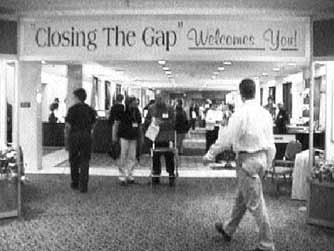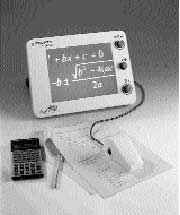|
Vol. 10 No. 1 Winter 2002 |
Subscribe to AT Messenger Download PDF Viewer |
Great Finds from Closing the Gap
by Dan Fendler, AT Specialist, Kent & Sussex ATRCs Closing the Gap,
the assistive technology (AT) conference and exhibition held in Minnesota each
fall, has always been the greatest place to see all the latest AT available.
This year was no exception. Here are a few examples of some interesting products
we learned about at this year's event.
Closing the Gap,
the assistive technology (AT) conference and exhibition held in Minnesota each
fall, has always been the greatest place to see all the latest AT available.
This year was no exception. Here are a few examples of some interesting products
we learned about at this year's event.
Exciting Products for Visual Impairment
Traditionally, magnification devices have been large and non-portable. The
advancement of digital imaging and small cameras has made portable magnification
devices possible and more affordable. Traditional CCTVs are useful at home
for magnifying printed material, but don't work as distance magnifiers because
you can't just point the camera at any distant objects, blackboards, or people
and magnify them. If the object you want to see is small and in your home,
CCTVs work fine.
Many of the new generation magnifiers include small, movable cameras that you can point at any object to display a larger image of the object on a video monitor. The cameras are small and light. Some cameras are available with a stand that can be used to magnify anything on your table or desk. Or you can rotate the camera to focus on any distant two- or three-dimensional object.

Figure 1
The Flipper™ (a device by Enhanced Vision Systems - see Figure 1) is shown magnifying a sculpture and displaying the larger image on a television screen. The camera is the small device between the bust and the television set. It is mounted on a small stand and can be rotated and pointed at anything you want to have magnified.

Figure 2
Portable magnification devices are sold by a number of different companies, and are available in several different configurations. A few of the cameras can be used with a pair of lightweight, futuristic-looking glasses in place of a television monitor. This makes the unit highly portable (see the FlipperPort™ - Figure 2).

Figure 3
Some have a mouse-like camera that can be rolled over a flat surface (see
the Liberty Plus - Figure 3).
These products are useful in home, work, and school environments. Most are available in several different configurations. Some can be used with computer monitors, with television sets, or with portable glasses. Here are a few websites you can browse to get a better feel for the types of options available:
Clarity af: www.clarityaf.com
Freedom Vision: www.freedomvision.net/
Enhanced Vision Systems: www.enhancedvision.com
If you don't have access to the web, you can call the ATRC in your county for more information. The units start at about $1,400, depending on what options you select.
Window-Eyes™ and Dragon Naturally Speaking®
If you are blind or have significant visual impairment and want to use a text-to-speech product like Dragon Naturally Speaking®, you may want to check out Window-Eyes™ (a screen reading product competing with JAWS®). GW Micro, Inc. stated in a product demo session that Window-Eyes™ will work with Dragon Naturally Speaking®. If you are a JAWS® user and want to use Dragon Naturally Speaking®, you need to purchase additional (and expensive) software. A GW Micro representative cautioned that, due to limitations of speech-to-text software, some non-technical users might experience difficulties with voice recognition setup. If you want more information, check out the GW Micro website at www.gwmicro.com. Better yet, download an evaluation copy of Window-Eyes™ and check it out yourself.
Co:Writer® for the AlphaSmart 3000
Co:Writer®, a computer-based word prediction program designed to help students who experience writing difficulties, is now available as an Applet for the AlphaSmart 3000. Co:Writer® can help students construct complete, grammatically correct sentences. The AlphaSmart 3000 is a lightweight, portable and rugged computer companion used by students all over the world. With the help of a grant from the Delaware Department of Education, we were able to purchase the Co:Writer® Applet for all the ATRCs.
Audiovisual FM System
AudiSee (Audisoft Technologies, Inc., www.audisoft.net) allows deaf and hard-of-hearing
students to read their teacher's lips, regardless of the teacher's movements
or the language of instruction. It also allows these students to maximize the
use of their residual hearing by using their current FM systems. Consisting
of a teacher's unit (Figure 4) and a student's unit (Figure 5), AudiSee transmits
a video of the teacher's lips to a small, computer-like device, which also
serves as an audio FM unit. The units sells for approximately $5,100. For more
information, check out their website: www.audisoft.net.

Figure 4

Figure 5
Task Training for People with Cognitive Impairment
Pocket Coach is a software/hardware system designed to provide fully customizable, step-by-step audio instructions or reminders to persons with cognitive impairment in any educational, vocational, or residential setting. It operates on Palmtop personal computers using the Windows CE operating system (Figure 6). The devices are fairly easy to program, and even easier to use. You can equip one with a small camera that will allow you to include pictures with task training.

Figure 6
There is also a version of the product in development called the Schedule Assistant. It is a software application being designed to help individuals with cognitive impairment independently manage their day-to-day schedules.
You can find out more about the product at www.ablelinktech.com.
If you have any questions about any the products mentioned, or any other area of Assistive Technology, give your local ATRC a call. To learn more about Closing the Gap, and plans for next year's conference, visit their website at www.closingthegap.com.

